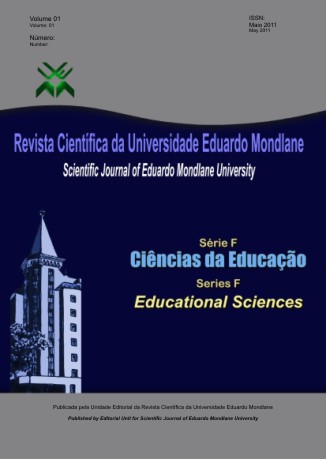O COMPORTAMENTO DE BEBÉS PERANTE A AUDIÇÃO DE UMA CANÇÃO DE EMBALAR
Resumo
A literatura sobre canções de embalar indica, por um lado, que este género vocal surge em diferentes partes do mundo como uma canção ligada à primeira infância; e por outro lado que o bebé exibe comportamentos diferenciados quando escuta uma canção de embalar. Neste artigo e irei centrar-me no estudo da canção de embalar abordando algumas caraterísticas que fazem dela um género musical com propósitos específicos. Descrevo estudos que reflectem como a audição de canções de embalar influência o comportamento do bebé nos períodos de sono. A partir de um estudo de caso realizado por mim, com bebés dos 4 aos 6 meses de idade, observei a forma como a audição de uma canção de embalar influenciou o comportamento dos mesmos, no período de sono. Uma das conclusões do estudo indica que, a audição da canção de embalar induz ao aquietamento e posterior adormecimento dos bebés e ao seu bem estar.
Referências
BLUM, T. Prenatal Experience and the Origins of Music: prenatal perception, Berlin: Leonardo Publ., 1993. p.252-277.
BONITO, R. Cancioneiro de Resende. Douro Litoral: Junta de Província do Douro Litoral, 1957.
CASTRO, M. I. R. de. Cantar aos bebés: das práticas de cantar durante a prestação de cuidados e dos efeitos de uma canção de embalar no sono dos bebés. Porto: Universidade do Porto, 2003 (Tese de Mestrado, FPCE/Universidade do Porto, 2003).
CASTRO, M. I. R. de. Cantando para adormecer. Revista Música, Psicologia e Educação, v. 6, p. 89-99, 2004.
CASTRO, M. I. R. de. Quando Cantar vem do Coração uma abordagem metodológica. Revista Educação, v. 4, n. 1, p. 87-97, 2012.
DELIÉGE, I.; SLOBODA, J. Musical Beginning: origins and development of musical competence. Oxford: Oxford University Press, 1996.
__________. Perception and cognition of Music. London: Psychology Press, 1997.
EIBL-EIBESFELDS, I. Human Ethology. New York: Aldine de Gruyter, 1989.
FERNALD, A. Intonation and communicative intent in mother`s speech to infants: is the melody the message? Child Development, v. 60, p. 1497-1510, 1989a.
FERNALD, A. A cross-language study of prosodic modifications in mother`s and father`s speech to preverbal infants, Journal Child Development, v. 16, p. 477-501, 1989b.
GALLEGO-ANDRÉS, J. História da Gente pouco importante - América e Europa até 1789. Lisboa: Editorial Estampa, 1993.
GIACOMETTI, M. Cancioneiro popular português. Lisboa: Círculo de Leitores, 1981.
GORDON, E. E. Teoria de aprendizagem musical para recém-nascidos e crianças em idade pré-escolar. Lisboa: Fundação Calouste Gulbenkian, 2000.
GRAÇA, F. L. A canção popular portuguesa. 4. ed. Lisboa: Caminho, 1991.
HARGREAVES, D. J. Musica y desarrollo psicologico, Barcelona: GRAÓ, 1998.
JOAQUIM, T. Dar à luz: ensaios sobre as práticas e crenças da gravidez, parto e pós-parto em Portugal. Lisboa: Dom Quixote, 1983.
KEMP, A. E. Music education and psychodynamic theory: the manifestation of separation and loss in music, Bulletin Psychotherapy Society, Oxford, n. 18, 1993.
KUNTZEL-HANSEN, M. Educacion Musical precoz y estimulación auditiva; Barcelona, Editorial Médica y Técnica, S.A., 3.ª edição, 1981.
LOPES DOS SANTOS, P. et al. Estudo das reacções do recém-nascido ao som de uma voz humana nas primeiras 48 horas de vida pós-parto. Jornal de Psicologia, v. 4, n. 5, p. 3-10, 1985.
____________. Papel dos factores da interacção Mãe-filho no crescimento somático do recém-nascido. Porto: Universidade do Porto, 1990. (Tese de Doutoramento, Faculdade de Psicologia e Ciências da Educação da Universidade do Porto, 1990).
NEVES, R. C. Canção de Embalar: Enciclopédia da Música em Portugal no Século XX. Temas e Debates, 2010 (Círculo de Leitores). A-C, 220.
PHILLIPS-SILVER, J.; TRAINOR, L. J. Hearing what the body feels: auditory encoding of rhythmic movement. Science Direct. Cognition 105, p. 533-546, 2007.
REID, S. Developments in infant observation, Routledge.1.a public, 1997.
ROCK, A. M. L.; TRAINOR, L. J.; ADDISON, T. L. Distinctive Messages in Infant-directed lullabies and play songs, Development Psychology, vol. 35, n. 2, p. 527-534, 1999.
RODRIGUES, H. Música para os pequeninos: elementos da perspectiva de Edwin Gordon. Associação Portuguesa de Educação Musical, p. 16-18, 1997.
RODRIGUES, H. A Festa da música na iniciação à vida: da musicalidade das primeiras interacções humanas às canções de embalar. Revista da Faculdade de Ciências Sociais e Humanas, Lisboa, Edições Colibri, n. 17, p. 61-80.
TRAINOR, L. J., (1996) Infant preferences for infant-directed versus noninfant- directed playsongs and lullabies, Infant Behavior and Development, v. 19, p. 83-92, 1996.
TRAINOR, L. J.; AUSTIN, C.M.; DESJARDINS, R.N. Is Infant-directed speech prosody a resulted of the vocal expression of emotion? Psychological Science, v.11, n. 3, p. 188-195, May 2000.
TREHUB, S.E.; UNYK, A.M.; TRAINOR, L.J. Adults identify infant-directed music across cultures, Infant Behavior and Development, 16, p. 193-211, 1993a.
____________.Maternal singing in cross-cultural perspective, v. 16, p. 285-295, 1993b.
TREHUB, S.E., et al. Mothers`and Fathers singing to Infants, Development Psychology, v. 33, n. 3, p. 500-507, 1997.
TREHUB, S. E.; SCHELLENBERG, G.; HILL, D., The origins of music perception and cognition: a development perspective. In: DELIÈGE; SLOBODA, J. A (ed). Perception and Cognition of Music. Psychology, p.103-128, 1997.
TREHUB, S. E, Developmental and applied perspectives on music. New York. Academy of Sciences. p. 189-201, 2005. Part IV.
TREHUB, S.E.; HANNON, E.E. Conventional rhythms enhance infants’ and adults’ perception of musical patterns. Science Direct, p. 110-118, 2009.
TREVARTHEN, C. Musicality and the intrinsic motive pulse: evidence from human psychobiology and infant communication, Musicae scientiae, ESCOM-European Society for the cognitive Sciences of Music, p.155-215. 1999.
ZENATTI, et al. Psychologie de la Musique, Press Universitaires de France, 1.ª edição,1997.

